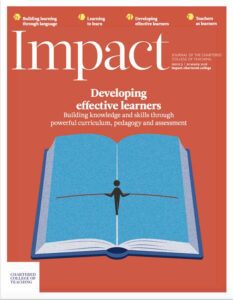Retrieval practice in practice: Using revision cards to change student misconceptions about how and when to revise

This is an extract from the Chartered College of Teaching’s Windows into the Classroom series, available now to all members on our Research and Practice Hub. You can read more about the authors’ approach, including pictures of students’ work and resources.
The challenge
Pendle Vale College (11-16) is a mixed secondary school with 1,050 students in the deprived area of Nelson, Lancashire. Like many other schools we faced a few challenges with the new Key Stage 4 qualifications; as students need to perform well on the day to be successful in their final exams.
It became apparent that students needed to take more responsibility for their revision. When we questioned students about how they were revising, we found that they were re-reading and highlighting key points in their books.
We also discovered that the class believed revision is something that happens in the weeks leading up to their exams, usually led by their teacher in catch-up sessions and last-minute cramming. They were unfamiliar with breaking up revision into smaller, more manageable chunks over a longer period of time.
We wanted to trial a new approach, so we focused on a Year 10 business studies class to use research and our experience to develop a strategy that:
- improved exam marks
- equipped the class with a revision strategy to support their exam and which they could apply across their other subjects
- showed pupils their own progress
- enabled pupils to retain their learning independently over time.
Our approach
After reading research on memory and retrieval techniques, we combined three theories – Dunlosky (Dunlosky, 2013), Heath and Heath (Heath and Heath, 2017) and Willingham (Willingham, 2008)– with our pedagogical knowledge and that of our students.
Instead of introducing a new revision strategy, we talked through how to apply our research to revision cards, which pupils were already familiar with as part of the school’s teaching and learning strategy, and introduced a system whereby, after each business studies lesson in which something new was taught, the pupils’ homework was to produce a single revision card with key learning points. They built up revision cards over time, using personal memory cues.
The starter activity for each lesson also became a mini retrieval task. We devised several differentiated questions, with scaffoldingProgressively introducing students to new concepts to support their learning for pupils who needed more support, around topics we felt most of the class needed more practice on. This information came from formative assessment and marking class books.
The aim is that prior learning will be revisited several times over the year to allow students to practise their retrieval skills, and revisit learning they may not have properly understood before. This will become regular, low-stakes testing, to get pupils into the cycle of revising, making a revision card and then demonstrating their retrieval skills in class.
Results
After a few lessons, students began to see for themselves how little-and-often revision straight after learning is more beneficial than last-minute cramming. This is a great motivator for them too – they can see benefits in their test results, which are improving lesson by lesson, as they continually practise questions they are not so strong in.
References
This article was published in February 2018 and reflects the terminology and understanding of research and evidence in use at the time. Some terms and conclusions may no longer align with current standards. We encourage readers to approach the content with an understanding of this context.










